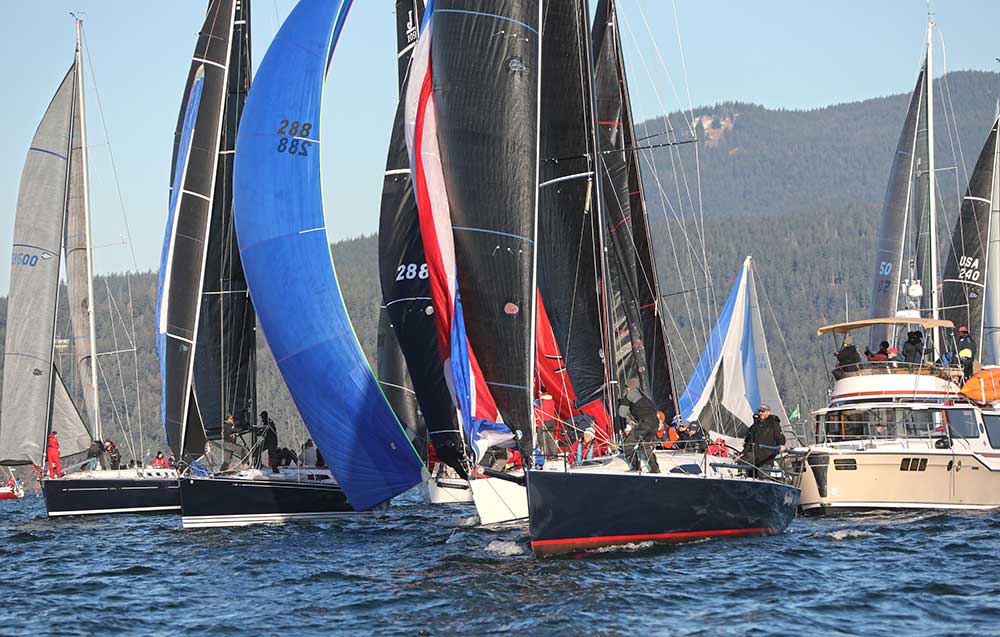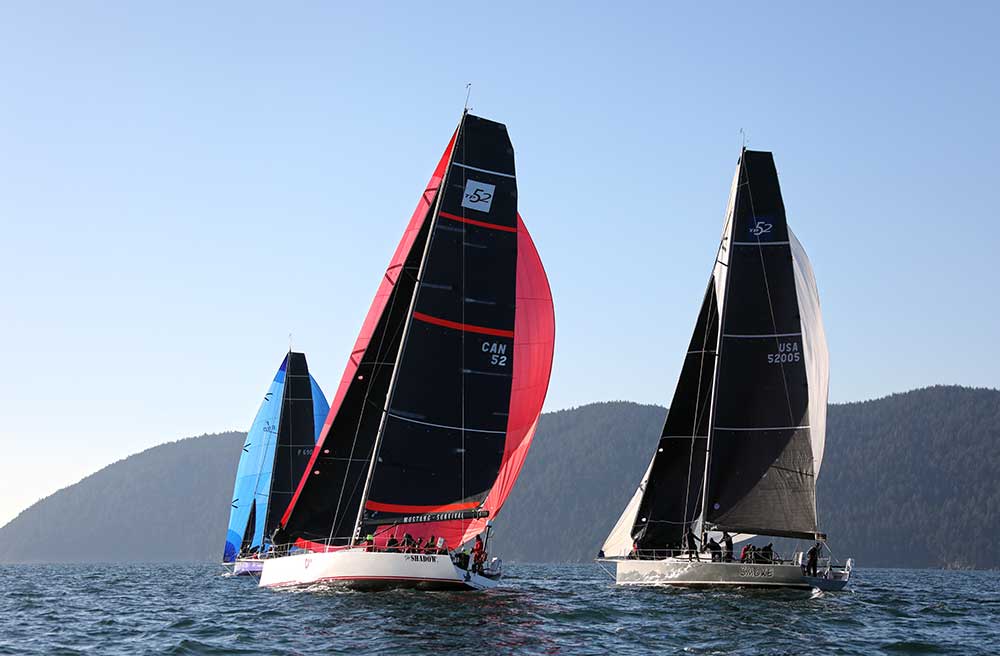Two days, 120 boats, 700 sailors, 65 miles… Another wonderful November circumnavigation of the San Juans.
Round the County has my heart. The two-day trip around the San Juans hosted by Orcas Island Yacht Club and Friday Harbor Sailing Club is among the most anticipated races on the calendar, and I would venture that a plurality of PNW sailors would call it their favorite race. Depending on the year, Round the County can dole out the raw power of the Salish Sea’s natural forces, or one of the prettiest race courses on Planet Earth, or both. This was a golden year with sun and enough breeze for at least some of the fleet to complete the course within the time limit each day.
As with human loved ones, a beloved race can simultaneously be dear and occasionally infuriating. This race saw high highs and low lows for many boats on the course, the one your author was aboard very much included. Yet, with it freshly in our wake, I know I’m in good company when I say that it was another genuinely wonderful Round the County. The course, the fleet, the location, the hospitality, even the occasionally frustrating conditions. Round the County just nails it, year in and year out.
For days leading up to Round the County weekend, and still in the wee hours of Saturday morning prior to the start, most of the smart money placed bets on an exceedingly light wind race — 0-6 knots on Saturday with perhaps slightly more on Sunday. It was forecast to be sunny, though, so things certainly could have looked worse. As the fleet of well over 100 boats motored to the start line, a 10-knot northerly greeted us in Rosario Strait. First: AWESOME, hope it holds. Second, BRRRRR, that is some seriously chilly wind. Mount Baker was on brilliant display, all your sailing pals were there, the breeze was twice as good as predicted — it was going to be a great day.

Round the County starts remain some of the busiest, most exciting affairs in PNW racing. They tend to be surprisingly civil, considering that there are approximately 40 boats of varying size and spanning several classes in each start; but it’s fair to say the chaos is a level up compared to what we’re accustomed to in this region.
Saturday’s start line felt especially long and offered two apparent courses of action — start on the east side (farther out in Rosario) for what looked like more breeze, or start on the other end closer to Lydia Shoal to begin down a ladder rung or two (or more, it was a really long line). As luck would have it, the breeze eventually compressed against the shore of Blakely Island, leaving the low-road starters with a pretty significant advantage of both position and breeze. I was sailing with the TP52 Glory, and we were on the fortunate side of that exchange, charging south under our A1.5 kite with a big lead over our class as we chased down the fleets that had started before us.

So that was that, the leaders extended and won easily, end of story, right? HA! Sailing south in Rosario Strait, the breeze began to lighten more and more. The boats behind brought a little pressure with them, and after about 12 of the day’s 31 miles, there was a consolidation at Davidson Rock. Our lead that had felt like a mile was down to boat lengths as we made the turn westward. That’s where it got funky and incredibly light.
The islands giveth and the islands taketh away… breeze, that is. On this pretty November day, the islands gaveth, big time, and those golden shores were heavenly indeed. On Glory, we headed out after Davidson, hypothesizing that if a breath of the northerly was going to trickle down, it would be coming up and over the islands, and would be offshore. Instead, shore breeze and a current river gave the inside boats insane wheels by comparison. As Glory and several others bobbed around well south of the island, boat after boat saw the writing on the wall, and tacked into the beach and cruised on by. What breeze there was was hardly consistent, and there were sail changes aplenty both along shore and outside. By the time we were working past the half-way point at Iceberg Point, several of our competitors were pretty much out of sight around the corner of San Juan Island. Oof.

Long after our day’s hope for a good result had sailed into the distance, we finally connected a few patches of carpet enough to get to the beach, and we short tacked with everybody else in the most stunning Salish Sea sunset, finishing in the last of the daylight. We headed through Mosquito Pass to Roche Harbor to relish the weekend’s other type of fun, in spite of our challenging day from a racing perspective. Docking at Roche in the dusky blue light was as magical as ever with the amphitheater of historic buildings illuminated with decorative lights. Hot toddies at the dock numbed our disappointment, morale got a big lift, and an evening of good times ensued for all 700-some sailors.
Day two dawned just as cold and just as windy as Saturday. If you thought the starting area on Saturday was exciting, it was even more so on Sunday — with shallows beyond the committee boat and some surprise kelp patties near the pin. The first classes powered up in a solid 10 knots of northerly, beating toward Stuart Island’s Turn Point. Round the County’s chase start leaves the fastest group of boats starting last. It turns out the final starters were a little over-eager, and had a general recall on our first attempt. By the second run at our sequence, the breeze had decreased slightly — a harbinger.
The beat to Turn Point could leave anyone feeling a little dizzy — so much current, and such big shifts. We cracked off to a shy reach believing we were fetching the point, before a shift left us working back close-hauled, eventually tacking in toward the shore. Finding the beneficial current was crucial as the breeze diminished in the point’s transition zone.
Once clear of Turn Point’s most tumultuous currents and very shifty breeze, the light air beat to Patos provided lots of opportunities to gain and lose. It seemed every patch of water was different, even when you were only a few boat lengths from another racer. We rubber-banded our way northeast. There seemed to be a slight advantage to the Pender/Saturna side, but the real differential didn’t show up until the northerly revealed itself once again coming down the Georgia Strait. Boats just a little too far on the San Juans side felt the pain, as the new pressure from the top left lit up boats on that side. Glory was on the fortunate receiving end of this, passing the Reichel/Pugh 55, Zvi, and holding off the rest of the fleet to be the first boat to make the turn and hoist a kite after Patos.

On the long run southeast, pressure built then dwindled, and built once more. The fleet consolidated as it lightened, and TP 52 Smoke led everyone’s jibes inside after Matia Island finding breeze and current advantage the closer they got to Orcas. We all worked back out to clear Sisters, and quickly jibed back in on the approach to Lawrence Point in the best breeze of the weekend, which was pushing into the low teens.
For the leading ORC boats, a final jibe out cleared Lawrence Point, but the ensuing jibe toward the Peapods revealed that we’d have to work hard to get to the finish. We all reached up, with crews hiking harder than at any other time of the circumnavigation. Every light patch, “up, up up!” Every puff, we came down trying to keep the boat on its feet.
We carried the kite as far as we could until we hit the brick wall of swirly breeze just past the Peapods. The wind bent westerly and dropped near nothing as we traded spinnakers for jibs and held our breath for a light air finish. Smoke and Mist tacked toward Orcas, while Glory and Zvi carried forward on the starboard tack we’d been sailing for some time. When the breeze went to zero, the current positioning showed Smoke and Mist to have made the right call. We focused hard, wringing every tenth of a knot out of our sails and hoping for steerage enough to avoid being swept past the line on the wrong side of the buoy. Just as our demise seemed inevitable, a light easterly came to play, allowing us enough maneuverability to sneak up and cross the line after Smoke and Mist, and before Zvi and the Canadian TP 52, The Shadow II. I can’t say I love the Round the County finish, but it sure does make things interesting; and is in good company with the challenging finishing locations of races like Swiftsure and Southern Straits.
Having been so involved in the antics within our own group of 50-footers, I was surprised to look around and discover that lots of other boats were right on our heels. Shadow II finished close enough behind us to correct above us again and finish the weekend as the top performing 52. But nobody in the ORC class could touch Peter Salusbury’s Riptide 35, Longboard. They finished the weekend correcting almost a half-hour ahead of the second place boat, and a stunning 3+ hours on corrected time ahead of a number of others in the class, including Glory. Hats off Longboard, Shadow, and everybody.
Around the fleet, division wins went to Dougie Barlow’s F28R Aliikai; Riptide 35, Longboard skippered by Peter Salusbur,y; Iain Christenson’s Farr 36, Annapurna; the Lanzingers on J/111 Hooligan; John Peterson’s J/109 Legacy; the Hoag and Peterson crew on Hobie 33 Tc; the Portland-based J/105 Free Bowl of Soup sailed by Schenk and Hopper; Jason Hofman and Ty Abrams’ Davidson 29 Kodiak; and Ian Sprenger’s Santa Cruz 27 Wilder.
Another Round the County 2022 is in the books, and I’ll remember this one as among my favorite Round the County weekends, and hopefully my worst Round the County result. Enormous thank yous to the skippers and crews whose effort to attend makes this event so special. And thanks, as always, to the gracious hosts who give us the opportunity for the region’s favorite fall racing get together.
Title background image courtesy of Jan Anderson.
Joe Cline
Joe Cline has been the Managing Editor of 48° North since 2014. From his career to his volunteer leadership in the marine industry, from racing sailboats large and small to his discovery of Pacific Northwest cruising —Joe is as sail-smitten as they come. Joe and his wife, Kaylin, have welcomed a couple of beautiful kiddos in the last few years, and he is enjoying fatherhood while still finding time to make a little music and even occasionally go sailing.






